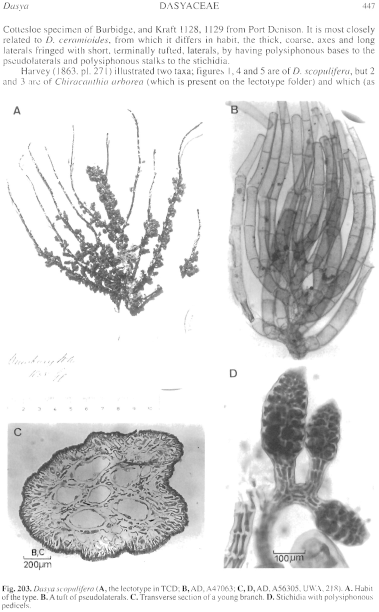|
|
|
|
|
|||||||||||
|
Electronic Flora of South Australia Species Fact Sheet
Phylum Rhodophyta – Order Ceramiales – Family Dasyaceae
Selected citations: De Toni 1903: 1185. Lucas 1912: 157. Silva et al. 1996: 438. Sonder 1881: 36. NON Womersley 1950: 181 (= D. ceramioides).
Synonym
Lophothalia? scopulifera (Harvey) J. Agardh 1890a: 61.
Thallus (Fig. 203A) dark red-brown, 20–40 cm high with a stout main axis and long laterals bearing short laterals 2–10 mm apart with tufted pseudolaterals. Main axis usually single, (1.5–) 2–4 mm in diameter, very heavily corticated, linear, occasionally slightly swollen between the short laterals, tapering slightly near the apex, smooth and denuded of pseudolaterals; long laterals similar to main axis. Short laterals simple or rarely branched, becoming tufted in older plants, usually 5–15 (–30) mm long, irregularly radially arranged, corticated but only 0.3–0.5 mm in diameter, terminating in compact tufts of incurved, large-celled, pseudolaterals. Holdfast conical, 4–10 mm across; probably usually epilithic. Structure. Pericentral cells 5, heavily corticated but usually remaining clear (by enlargement) in transverse sections (Fig. 203C), with rhizoidal filaments surrounding the pericentral cells and often obscuring them in the laterals. Pseudolaterals (Fig. 203B) one per segment, lost from older branches, 1–2 mm long, subdichotomously branched 2–3 (–4) times at each cell near their base with 1–2 (–4) basal segments becoming polysiphonous with up to 5 pericentral cells. Upper monosiphonous parts large celled, 90–230 µm in diameter with cells L/D 1.5–2.5 (–3), tapering to acute apices. Adventitious monosiphonous filaments absent. Rhodoplasts discoid.
Reproduction: Procarps spirally arranged on several successive polysiphonous segments. Cystocarps sessile on corticated laterals, globose and urceolate, 800–900 µm in diameter with a prominent corticated neck 0.5–1 as long as the cystocarp diameter. Spermatangial branches unknown.
Stichidia (Fig. 203D) in clusters at the base of pseudolaterals, on polysiphonous stalks (1–) 2–4 (–6) segments long with 5 pericentral cells plus small corticating cells, slightly curved, 250–500 µm long and 100–150 µm in diameter, with 5 pericentral cells all becoming fertile. Tetrasporangia 35–45 µm in diameter, each with three cover cells which cover 0.5–0.8 of the tetrasporangium.
Type from Bunbury, W. Aust. (Clifton 64, 1855); lectotype in TCD (see below).
Selected specimens: Port Denison, W. Aust., drift (Kraft 1128 and 1129, July 1967; MELU, copies in AD, A52988, A52989). Cottesloe, W. Aust. (Burbidge, June 1934; UWA, 218, copy AD, A56305). Collie Head, Cockburn Sound, W. Aust., on Posidonia (Cambridge, 18.v.1971; AD, A47063).
Distribution: Port Denison to Bunbury, W. Aust.
Taxonomic notes: While Dasya scopulifera is not known with certainty from the southern Australian region, the type locality is just north of Cape Naturaliste and the species would be expected to occur in the southern region.
Dasya scopulifera is apparently a rare, deep water, species known largely from drift specimens, few of which are fertile; the above description is based largely on the type, the
Cottesloe specimen of Burbidge, and Kraft 1128, 1129 from Port Denison. It is most closely related to D. ceramioides, from which it differs in habit, the thick, coarse, axes and long laterals fringed with short, terminally tufted, laterals, by having polysiphonous bases to the pseudolaterals and polysiphonous stalks to the stichidia.
Harvey (1863, pl. 271) illustrated two taxa; figures 1, 4 and 5 are of D. scopulifera, but 2 and 3 are of Chiracanthia arborea (which is present on the lectotype folder) and which (as
Harvey drew) has cystocarps without necks and with elongate carposporangia arising directly from the fusion cell (as typical for most Rhodomelaceae). The lectotype sheet bears a characteristic specimen of D. scopulifera similar to Harvey's fig. 1, and a packet of fragments which have young stichidia. This sheet was annotated as TYPE by H.B.S.W. (in 1952), and is now considered to be the lectotype although Harvey stated that stichidia were unknown and his illustration of a cystocarp applies to Chiracanthia.
Other fine specimens from Red Bluff, Kalbarri, W. Aust., 6–9 m deep (Kraft & Ricker, 15.xii.1980; MELU) are 20–40 cm high and are typical in habit for D. scopulifera, with short laterals bearing pseudolaterals along their whole length of 2–4 cm, and thick axes and main laterals. Unfortunately these 6 specimens are all sterile, but it is possible that the known fertile plants of this species are second year plants and that those in their first year, while well grown, do not become fertile.
References:
AGARDH, J.G. (1890a). Till algernes systematik. Acta Univ. lund. 26(3), 1–125, Plates 1–3.
DE TONI, G.B. (1903). Sylloge Algarum omnium hucusque Cognitarum. Vol. 4. Florideae. Sect. 3, pp. 775–1521 + 1523–1525. (Padua.)
HARVEY, W.H. (1863). Phycologia Australica. Vol. 5, Plates 241–300, synop., pp. i-lxxiii. (Reeve: London.)
LUCAS, A.H.S. (1912). Supplementary list of the marine algae of Australia. Proc. Linn. Soc. N.S.W. 37, 157–171.
SILVA, P.C., BASSON, P.W. & MOE, R.L. (1996). Catalogue of the Benthic Marine Algae of the Indian Ocean. (University of California Press: Berkeley, Los Angeles & London.)
SONDER, O.W. (1881). In Mueller, F., Fragmenta Phytographiae Australiae. Supplementum ad volumen undecinum: Algae Australianae hactenus cognitae, pp. 1–42, 105–107. (Melbourne.)
WOMERSLEY, H.B.S. (1950). The marine algae of Kangaroo Island. III. List of Species 1. Trans. R. Soc. S. Aust. 73, 137–197.
The Marine Benthic Flora of Southern Australia Part IIIC complete list of references.
Publication:
Womersley, H.B.S. (24 December, 1998)
The Marine Benthic Flora of Southern Australia
Rhodophyta. Part IIIC. Ceramiales – Ceramiaceae, Dasyaceae
©State Herbarium of South Australia, Government of South Australia
Illustration in Womersley Part IIIA, 1998: FIG. 203.

Figure 203 enlarge
Fig. 203. Dasya scopulifera (A, the lectotype in TCD; B, AD, A47063; C, D, AD, A56305, UWA, 218). A. Habit of the type. B. A tuft of pseudolaterals. C. Transverse section of a young branch. D. Stichidia with polysiphonous pedicels.

|
Email Contact: State Herbarium of South Australia |

|